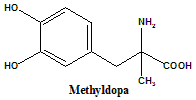METHYLDOPA Synthesis, SAR, MCQ,Structure,Chemical Properties and Therapeutic Uses
Methyldopa
IUPAC nomenclature
(S)-2-amino-3-(3,4-dihydroxyphenyl)-2-methyl-propanoic acid.

Classification
Methyldopa is an α2-Adrenergic agonist. [1]
Physiochemical Properties
| S. NO. | PHYSICAL AND CHEMICAL PROPERTIES | |
| 1 | Molecular weight | 211.21 g/mol |
| 2 | Physical appearance | Present in colorless crystals form, it is present in sesquihydrate form. |
| 3 | Melting point | 300°C |
| 4 | Solubility | Insoluble in common organic solvents, soluble in water |
| 5 | Presence of ring | Benzene ring |
| 6 | Number of chiral centers | 1 |
Mechanism of Action
i. Methyldopa converts into its metabolite, α-methylnorephrine which stimulates the central inhibitory α-adrenergic receptors.
ii. Its leads to reduction in sympathetic tone, blood pressure and total peripheral resistance.
iii. Inhibition of decarboxylation of dihydroxyphnylalanine(dopa) and 5-hydroxytryptophan in the CNS, which produces antihypertensive effects.
Structure Activity Relationship
- Primary or secondary aliphatic amine separated by two carbons from a substituted benzene ring is essential for the high agonist activity.
- The hydroxyl substituted carbon must be in the R configuration for the maximal direct activity.
R1 substitution:
- When R1 is increased in size, activity of alpha receptors decreases and activity of the beta receptors increases
- Activity of both alpha and beta receptors is maximum when R1 is methyl group.
- Alpha agonist activity decreases when R1 is larger than methyl, and went negligible when R1 is isopropyl.
- Large lipophillic groups can afford compounds with alpha blocking activity.
- N-substituent provides selectivity for different receptors.
- Arylalkyl group can provide beta selectivity, increased cell penetration and increased lipophillicity for the longer duration of action.
R2 substitution:
- Ethyl group can eliminate the alpha activity of the drug.
- Erythrostero isomers have maximal activity.
- The additional methyl group makes the drug more selective for the alpha2
R3 substitution on the aromatic ring:
- 3’,4’-dihydroxy substituted benzene ring has poor oral activity.
- 3’, 5’-dihydroxy compounds are orally active.
- At least one of the groups is required which can form hydrogen bonds. And if only one group is present then it is preferred at 4’ position to retain the beta2
- If phenyl group has no phenolic substituent then it may act directly or indirectly.[2]
Method of synthesis
i. 4-hydroxy-3-methoxy phenylacetone is taken as starting material.
ii. It undergoes reaction with ammonium chloride followed by reaction with potassium cyanide to α-amino nitrile compound.
iii. L-isomer is separated out by rection with camphosulfonic acid.
iv. On reating with sulfuric acid, we get methyldopa as final product.

Therapeutic Uses
The drug used for the treatment of:
- High blood pressure
- Pregnancy induced hypertension
- Pre-eclampsia
Side Effects
Psychological side effects like depression, apathy, anxiety, sedation, cognitive and memory impairment, etc.
Physiological side effects like lightheadedness, miosis, xerostomia, GIT disturbances, Migrain, etc.
MCQs
Q.1 What can be the correct IUPAC nomenclature of Methyldopa?
a) (S)3-(3,4-dihydroxyphenyl)-2-methyl-propanoic acid
b) (S)-2-amino-3-(3,4-dihydroxyphenyl)-2-methyl-butanoic acid
c) (S)-2-amino-3-(3,4-dihydroxyphenyl)-2-ethyl-propanoic acid
d) (S)-2-amino-3-(3,4-dihydroxyphenyl)-2-methyl-propanoic acid
Q.2 Which amongst the following statements is/are correct related to the SAR of methyldopa?
I. The hydroxyl substituted carbon must be in the R configuration for the maximal direct activity.
II. Large lipophillic groups at R 1 can afford compounds with alpha blocking activity
III. Ethyl group at R2 can eliminate the alpha activity of the drug.
a) I, II
b) I, III
c) II, III
d) I, II, III
Q.3 The correct order for the synthesis of drug Methyldopa can be?
I. 4-hydroxy-3-methoxy phenylacetone reacts with ammonium chloride.
II. Reaction with camphosulfonic acid
III. Reaction with potassium cyanide
IV. Reaction with sulfuric acid
a) I – IV – II – III
b) I – IV – III – II
c) I – III – II – IV
d) I – III – IV – II
Q.4 Side effects of drug methyldopa is/are?
a) Depression
b) Anxiety
c) Miosis
d) All of the above
Q.5 Match the following drugs with their correct melting points-
| i. Methyldopa | A. 300°C |
| ii. Dopamine | B. 128°C |
| iii. Clonidine | C. 130°C |
| iv. Dobutamine | D. 185°C |
a) i-D, ii-C, iii-B, iv-A
b) i-B, ii-D, iii-C, iv-A
c) i-B, ii-A, iii-C, iv-D
d) i-C, ii-A, iii-B, iv-D
Q.6 An example of drug from class α2-Adrenergic agonist?
a) Methyldopa
b) Clonidine
c) Albuterol
d) Bitolterol
Q.7 The type of ring system found in Methyldopa?
a) Benzene ring
b) Oxazophosphorine ring
c) Naphthalene
d) Imidazoline ring
ANSWERS
1-d
2-d
3-c
4-d
5-a
6-a
7-a
REFERENCES
[1] Lemke TL, Zito SW, Roche VF, Williams DA. Essentials of Foye’s principles of medicinal chemistry. Wolters Kluwer; 2017, 340 [2] Lemke TL, Zito SW, Roche VF, Williams DA. Essentials of Foye’s principles of medicinal chemistry. Wolters Kluwer; 2017, 348-352